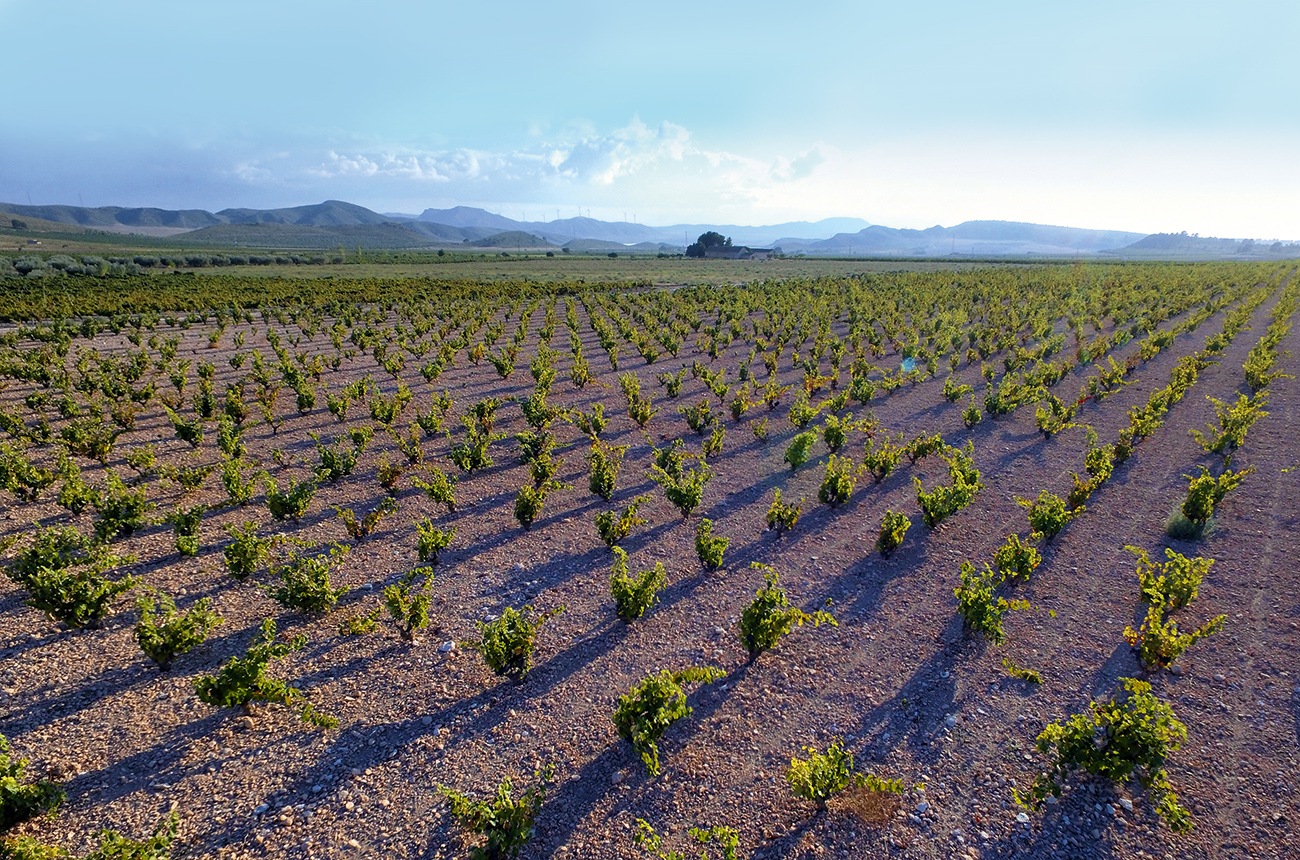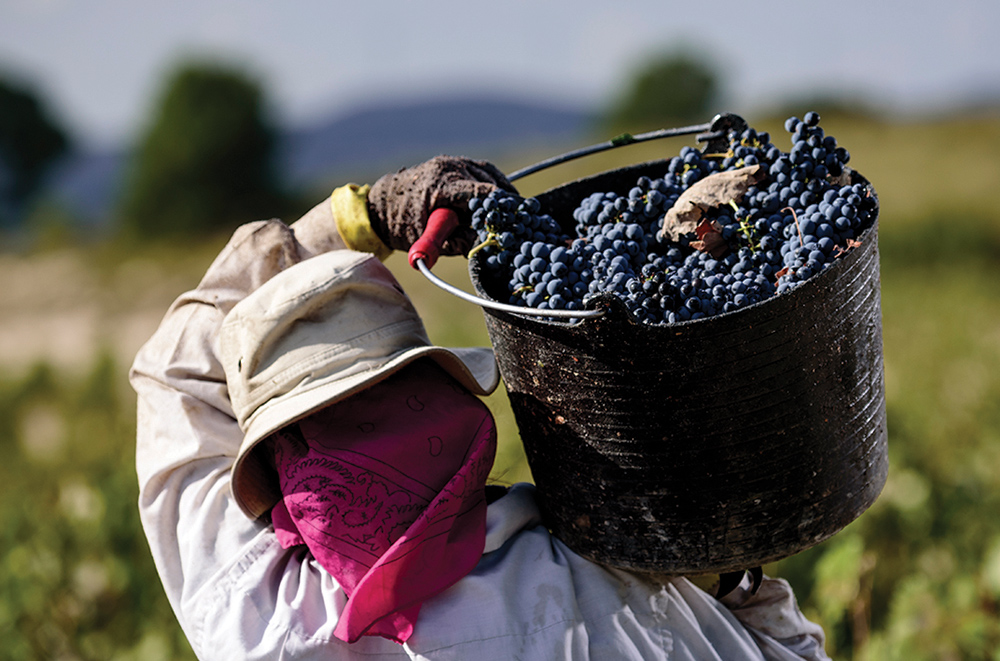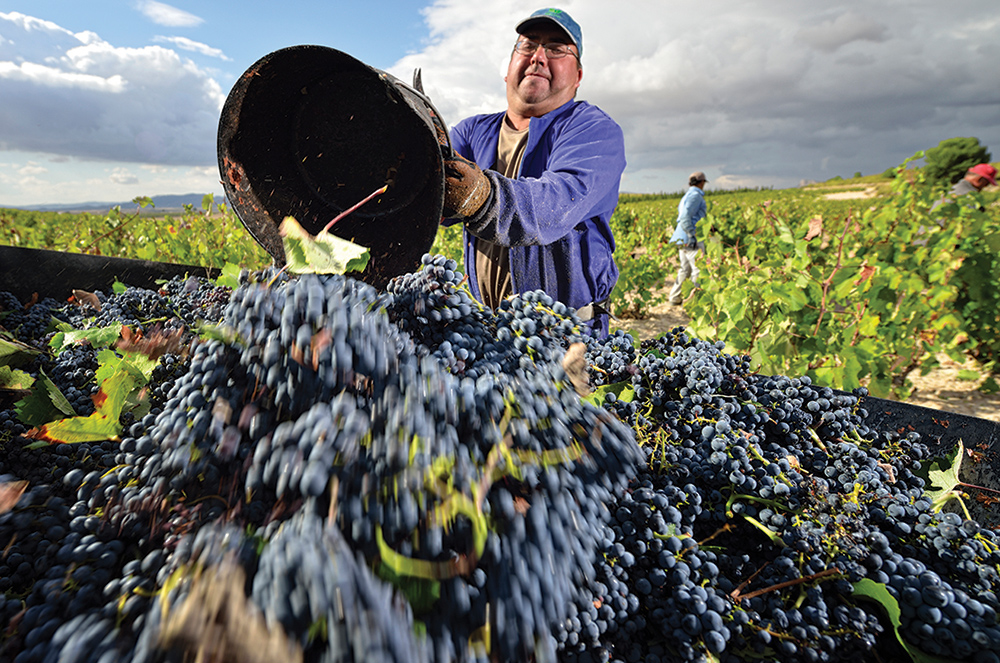Undulating plains of sand-coloured earth are broken up by neatly striped rows of vines and stippled with olive groves. A solitary windmill sites in the windswept fertile plateau, the horizon stretching into the blue distance, where hills are dotted with their 21st century equivalent, wind turbines. Add abundant castles picturesquely ruined, plus a dearth of tourists and it’s Spain as Cervantes might have seen it. Welcome to Jumilla.
Firstly, let’s get the pronunciation right – who-ME-ah. Next, you need to know where it is, exactly. Head south out of Madrid, over the flat plains of La Mancha, until you see the mountains of Tobarra – this is where the Jumilla Destination of Origin (DO) starts, in a high altitude valley flanked by the towns of Alicante, Albacete and Murcia, about 50 miles inland from the Mediterranean coast.
It’s hot here – extremely hot. But the nights are cool, thanks to its significant elevation above sea level, which means that the grapes can rest and retain that sought after freshness. And what grapes – or rather one grape in particular, Jumilla is Monastrell country.
Monastrell is a late-ripening variety (more of which later), which thrives in the heat here and produces wines that range from lively and fruity, to stunningly complex. And here’s the best bit – prices are generally very reasonable.

Another thing worth knowing: in many of Jumilla’s vineyards Monastrell vines remain ungrafted (that is, on their own roots), phylloxera never having penetrated the limestone soils here, thanks to all that sun, combined with low humidity, and that mountain range, which acts as a barrier. Put all of this together and a picture starts to emerge of Jumilla as an exciting, blossoming wine region – one to watch.
Not that it’s a new region. Jumilla is actually one of the oldest DOs in Spain, created in 1966. We’re talking over 2000 winegrowers and 45 registered wineries. How big is the Jumilla DO, exactly? It comprises around 19,000 hectares of vineyards scattered between the provinces of Murcie and Albacete, of which 40% are located in the town of Jumilla. The rest are spread between the towns of Montealegre del Castillo, Fuente Alamo, Tobarra, Hellin, Ontur and Albatana, in descending order of vineyard size.
Each of the wine towns in Jumilla has its own feel and story, from Fuente Alamo, situated in the north of the DO, which is pretty much surrounded by vineyards, to the ancient town of Montealegre, with a history that stretches back over many thousand years.
And they all love to party, setting off fire crackers at every opportunity – the biggest celebration of all held during Semana Santa (Holy Week) when just about everyone will bang a drum (tamborada). While in August, Jumilla town holds a 10-day harvest festival (fiestas de la vendimia), complete with a wine parade, even a wine battle (don’t ask).

So what has contributed towards Jumilla winning its moniker, Spain’s rising star? As in all winemaking, it starts with the soil. The region lies at a crossroads between Andalucía, La Mancha and Valencia and sits on a high plain that represents the transition between the Castilian plateau and the Mediterranean Eastern Seaboard. We’re talking mostly limestone soils and a dry climate – only 300mm of annual rainfall, and more than 3000 hours of sunlight.
Winters are cold here, with frequent frosts, while summers, as mentioned, are hot and dry – these are ideal growing conditions for a rather special grape, Jumilla native Monastrell, which hogs 70% of the production, and waves the flag for regional identity.
Known internationally as Mourvèdre, Monastrell is a low yielding, thick- skinned, small berry, with compact grape clusters. Hardy, too, because as well as being resistant to the dreaded phylloxera, it also repels other nasties, such as grey mould and moths. Consequently, organic viticulture thrives here –in fact, in Jumilla town over 94% of the grapes are organic.
So what are the flavour characteristics of Monastrell? It produces potent, expressive wines with a characteristic purplish colour and abundant fruit aromas. Rich and mellow in the mouth,these wines might have an average ABV 14%, but the winemaking know-how here means balanced wines, thanks in part to plentiful use of concrete vats, which keep the wines fresh-tasting, preserving the grape variety’s characteristics.

And in the Jumilla region, Monastrell can produce wines that can scale the heights, regularly scoring high marks in international competitions and wine guides, such as the 99 points awarded by Robert Parker to Casa Castillo Pie Franco’s 2017 Monastrell.
There are other red varieties grown here, too, of course, among them Garnacha, Garnacha Tintorera and Cencibel (Tempranillo), which, together with Monastrell turn out some particularly vivacious, fruit-forward blends, while the majority of rosés are made using a short maceration to extract the best colour and flavour from the skins.
The use of international varieties has also been approved in Jumilla, such as Cabernet Sauvignon, Merlot, Petit Verdot and Syrah. In fact, Syrah, thanks to its Mediterranean origins, has adapted perfectly to the region – indeed many of Jumilla’s new style wines making waves on the international stage are made with 100% Syrah and Monastrell blends containing Syrah.
While white varieties planted include Airén, Macabeo, Malvasia, Chardonnay and Sauvignon Blanc, which are producing a range of beautifully balanced, aromatic wines. Plus there are also some interesting wines emerging that are made with the Moscatel de Grado Menudo grape and Verdejo, which showcases the region’s terroir. Not forgetting Jumilla’s sweet wines, both reds and whites, with a special nod to the region’s port-like Monastrell (don’t miss the one from Bodegas Olivares), with its intense colour and rich, sultry aromas and flavours, that completes Jumilla’s diverse offering.
Cruise around Jumilla’s wineries today and you’ll see all the latest kit. Producers here take full advantage of the most modern winemaking techniques and industry innovations, from roll crushers to pneumatic presses, all with the aim of getting the best out of the grapes.

Ditto ageing. Cellars here boast constant cool temperatures year round with carefully measured humidity and ventilation, and winemakers allocate their top wines to barrels made of the best oak that they can find for wines that need ageing. That said, Jumilla’s unoaked wines, which are relative newcomers to the market, are also worth exploring, packed with fresh-tasting fruit.
And talking of Jumilla’s winemaking prowess, winemakers here regularly think out of the box to achieve the most exciting flavours and extract the best from the fruit – think amphora, foudres, even concrete egg fermenters, combining traditional techniques with a modern outlook in their quest to build a Jumilla identity and achieve a distinctive terroir.
And while the climate plays ball most years, such are the near perfect growing conditions, there is some vintage variation, with the very best years considered to be 1998 and 2004. Though really every year is a good year in Jumilla – the last decade in particular.
The easiest way for visitors to get a proper taste of Jumilla is to follow its Wine Route. All participating wineries sell wine, olive oil, almonds, and many other regional products, and most offer tours. Though pre-booking is necessary, especially if you want an English-speaking guide, tours priced between €5-€10 per head.

Silvano Garcia, president of the DOP Regulatory Council
Wineries to visit include the late 19th century-built Alceño, and Silvano Garcia,both centrally located in the town of Jumilla, while there are others to visit on the outskirts of town, such as Viña Campanero, Bodegas Bleda and B.S.I, which hold tours and boast wine shops.
Dotted around the region you’ll find many other wineries to visit. In the Carche Valley try Carchelo, Hacienda del Carche – Casa de la Ermita wine museum, and Madrid Romero, which offers a fine dining restaurant, Bodega Gastronómica, also worth a visit.
While in the middle of the countryside, head to wineries such as Luzón, Viña Elena, Xenysel, Juan Gil, or Casa Rojo. And then combine wine with culture and visit the Franciscan convent of Santa Ana del Monte, standing high up in the mountains to the south of Jumilla. Or make tracks to Iberian settlement, Coimbra del Barranco Ancho, in the Sierra de Santa Ana, that dates back over 2000 years, complete with burial grounds, or check out the cave paintings and fossilised footprints found in the Sierra de la Pedrera.
The Wine Route also suggests visits to a number of Jumilla’s fascinating museums, such as the Jeronimo Molina Archaelogical Museum, with its impressive collection of items from nearby pre-historic settlements, including fossils of grape seeds dating back to 3000 BC, and its Etnographic and Natural Science Museum, also worth a look. In addition, there’s the Iglesia Mayor de Santiago, which boasts a splendid 16th century altarpiece depicting the pilgrimage to Santiago from the Holy Land, and El Casón, a perfectly preserved late-Roman 5th century mausoleum measuring just three metres by two. After, drop by olive oil producer, Casa Pareja, a veritable paradise of organically grown olives and fruits.

Wines from DOP Jumilla at the 25th Quality Awards Ceremony
Drive north and you’ll discover Hellin and its ancient old town, where Arabs once settled, so make time to stroll through the narrow streets. Also visit the equally atmospheric wine towns of Albatana, Tobarra and Ontur, where Roman dolls made of bone and amber were once found, taking time to walk through the vineyards and fragrant olive groves that surround each town. Just outside Ontur, there is the Pio del Ramo Cellar, a pioneer in organic agriculture.
You could stay over in the Mainetes Hotel, situated in a boutique winery, complete with restaurant and stylish bedrooms in a beautiful country house. And while you’re there, visit Bodegas Cerrón, a family-owned winery devoted to biodynamic winemaking and organic goat cheese, also check out the wines from the Ontalba and San Dionisio cooperatives, the biggest players in the cooler, slightly higher altitude Albacete area, which offers more stunning landscapes with which to feast the eyes.
Where there’s good wine, there’s good food, right? Like many Spanish regions, Jumilla has a strong food culture, and the cuisine here is as richly flavoured as the wine. The most well known dish is gazpacho Jumillano, a curious Jewish recipe traditionally made with game, and nothing like the southern Spanish soup. Also good are the empanadas de patatas, a speciality offered during Semana Santa (Easter week).
Other dishes to look out for include rice with rabbit and snails, a popular combination, along with ‘relleno’ or ‘pelotas’ – chicken meatballs, and pan-fried baby goat. And don’t miss the goat cheese fried in olive oil with tomato – the cheese made with milk produced by native goat breed, Murciano-Granadina. Not forgetting mortiriguelo – a soup made with offal, and trigoentero, an Easter vegetable broth.
You have a sweet tooth? Then you’ll do well in Jumilla. The region’s most famous desserts are sequillos, sweet pastries decorated with meringues. Then there are pirusas, made with aniseed, cristobalas, made with almonds and cinnamon, and ring doughnut-shaped rollos de vino (yup, made with wine) – the lot a perfect match with a glass of sweet Monastrell. It’s clear that wine is not the only reason to come here – there’s so much more to discover in Jumilla.





